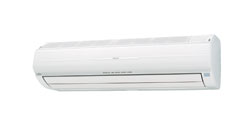Split system air conditioners need to do more to meet the demanding needs of end users, writes Paul Kingswell of Axair Climate
Without doubt, there are still some end users who are prepared to settle for a bog-standard air conditioner at the cheapest possible price.
But there are now many more who expect a bit extra from their air conditioning – in essence, they are looking for added value.
For many, that added value may come from lower cost of ownership, largely through reduced running costs. At the same time, they do not want to compromise on their comfort levels. The vast proliferation of inverter-controlled units is clear evidence of the demand for higher efficiencies while maintaining a responsive system – as well as meeting end users’ requirements for enhanced capital allowances (ECA).
But inverters are not the be-all and end-all of energy efficiency. For example, many split systems lose efficiency with use as the filter becomes clogged with dust between maintenance visits. And, although it should not happen, it is a fact that many building operators do not get their split systems serviced as often as they should.
This issue was clearly recognised by judges at the recent HEVAR show in Manchester, who commended the automatic filter-cleaning function incorporated into the new Fujitsu Nocria ceiling/wall split, displayed on the Axair Climate stand. Believed to be a world-first, this unit prevents the filters from becoming clogged with dust, in a process that takes less than two minutes every couple of weeks, to provide more than 25% energy savings as well as smoother air flows.
The issue of filtration highlights another concern of end users that manufacturers are beginning to address. Building occupiers and operators are increasingly concerned about the quality of air in the workplace. And, while smoking in the workplace is now a thing of the past, there are many other pollutants to contend with.
In larger buildings with central plant air conditioning and ventilation, indoor air quality (IAQ) issues are generally taken care of with air-handling units. In smaller spaces using split systems, the majority of splits will filter the air as it passes through the unit but there is no fresh air introduced.
For many end users, (and for ever-stricter building regulations), this is not good enough. As a result, split systems coming on to the market now are beginning to address this with a much higher level of air cleaning and filtration.
A case in point is the integration of plasma filtration into a split system. Extensively tested under both laboratory and field conditions, plasma filtration employs an ionisation process to deactivate viruses, bacteria, mould spores and allergenic chemicals. It also removes odours such as cigarette smoke, rubbish smells and body odour.
Many HVR readers may recall the air-cleaning ionisers that flooded the market in the early 1990s, often accompanied by greatly exaggerated claims for performance. These ionisers generated negative ions only, and this was the reason for their limited success.
In contrast, plasma filters in split systems subject return air to a barrage of equal numbers of positive and negative ions, an ionic balance equivalent to that found in natural fresh air. For instance, a cubic centimetre of air from a forest contains around 4,200 ions of each type of ion. The same volume of typical city air, however, contains around 500 positive and 100 negative ions.
The electrostatically charged particles generated by a plasma filter have the effect of attracting other ions from cell membranes of airborne microbes such as bacteria and moulds, causing sufficient damage to deactivate them. To reinforce this process, plasma filters also produce ozone, which is widely used as a disinfectant and can sterilise airborne microbes.
Similarly, many of the chemicals often found in indoor air are also attracted to the plasma-generated ions and deactivated. Tests have shown that these include ammonia, acetaldehyde, acetic acid, methane gas, carbon monoxide, nitrogen monoxide and formaldehyde – many of which have been associated with sick building syndrome.
Any positively charged dust particles that escape this treatment are then mopped up by an earthed section of the filter and collected by a disinfection and deodorising filter containing activated charcoal.

Fujitsu Nocria
Advanced plasma filtration units may also incorporate additional lines of defence, such as a polyphenol ceraglaze coating on elements of the filter to provide further disinfection. Combining these features with an internal drying process to remove moisture from inside the unit ensures there are no suitable conditions for bacterial growth.
The sophistication of such measures, and the investment made by air-conditioning manufacturers in developing them, is a clear indication of the increasing importance of air quality to end users.
In recent years, air conditioning has frequently been criticised for
its contribution to the energy consumption and carbon emissions of buildings, and its association with sick building syndrome in some cases.
With innovations such as ECA-qualifying self-cleaning filters and enhanced air filtration, the latest models of split system are addressing these issues, and meeting a growing need among end users who look further than initial capital cost.
www.axairclimate.co.uk